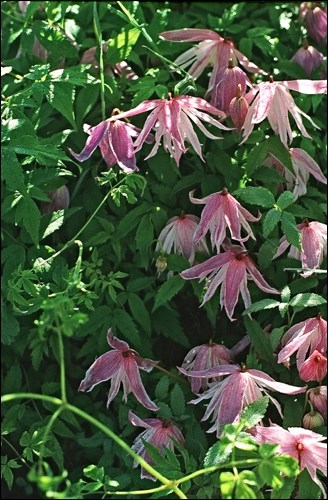Clematis are among our most beautiful vines. Some do well on the prairies with average care, while others need coddling coupled with protected micro-climate and yet they still may not survive our winters. However, in garden centres and nurseries, they all share equal space. So how does one know if the plant you’re getting is ruggedly hardy or needs shelter? Begin with the Latin or botanical name – always listed on the plant tag in italics.
The hybrids of two species, Clematis alpina and Clematis macropetala are among the loveliest and toughest. They vary in height from 2.6 to four metres and climb by means of twinning leaf petioles and bloom on the previous year’s growth from late spring to early summer. Both need little pruning unless they’re blocking a window or an arbour. They benefit from being planted in deep, organically enriched soil with a 10-centimetre layer of organic mulch at their base and deep watering (to a depth of 45 centimetres) every two weeks. Bloom is greater if the vine is in sunlight. These clematis are hardy, easy to grow and vigorous. No fuss, no muss.
The alpine clematis (Clematis alpina) is native to Europe and Asia, has bi-ternately compound leaves (meaning each leaf consists of three groups of three leaflets), produces bell-shaped flowers in white, pink or blue and generally reaches a height of two to 2.5 metres. Among these cultivars are Ruby with deep pink flowers, Willy with pale pink flowers with a darker edge, Constance with almost red flowers and Francis Rivis and Pamela Jackman with blue flowers.
The large petaled clematis (Clematis macropetela), native to China, is slightly taller, generally between 3.6 and four metres with bell-shaped flowers. Prairie plant breeders such as Frank Skinner and Stan Zubrowski developed several cultivars. Among the Skinner introductions are Blue Bird with lavender blue flowers, Rosy O’Grady with long pink pointed sepals and White Swan with flowers as you would expect – snow white. Joe Zary, honouring one of Saskatoon’s promoters of horticulture, has double purple flowers and was introduced by Stan Zubrowski of Prairie River. Other Clematis macropetala cultivars include Lagoon and Maidwell Hall with blue flowers, and Markham’s Pink with pink flowers.
Two large, very vigorous, drought tolerant and determinedly hardy clematis are the golden clematis (Clematis tangutica) and prairie traveller’s joy (Clematis vitalba). Both are excellent as ground covers for large areas of a sunny exposed hill or bank or for hiding something large and ugly such as a neighbour’s deteriorating shed (simply plant it in the cover of darkness). These vines lack social graces so consider carefully where you place them. A long blooming and slightly more contained cultivar of the golden clematis is Bill MacKenzie.
Different from all of the above are the cultivars of herbaceous Clematis integrifolia and the climbing Clematis jackmanii. They begin growth each spring at ground level and climb to about three metres blooming on the current season’s growth in late summer. Although the roots survive, the aboveground portion is killed to soil level each winter and must be pruned off in early spring. One of the best known of these is Blue Boy, introduced by Frank Skinner in 1947. A more recent introduction from Latvia is Pamjat Serdsta with light violet flowers.
Try some of these. You won’t be disappointed.
Sara Williams is the author of the newly revised Creating the Prairie Xeriscape and the Saskatoon Forestry Farm Park & Zoo: A Photographic History. Just back from Morocco, Sara will also be hosting a tour to Ireland in September. For more information, call Ruth at 1-888-778-2378.
— This column is provided courtesy of the Saskatchewan Perennial Society (www.saskperennial.ca; hortscene@yahoo.com). Check out our Bulletin Board or Calendar for upcoming garden information sessions: master gardener courses at the University of Saskatchewan (https://ccde.usask.ca/mastergardener).



